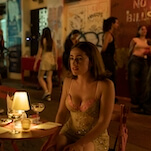China Miéville understands the value of place. His novel Perdido Street Station brought him to prominence with its strong writing and the remarkable vitality of its setting. Not content to regurgitate old genre clichés, he made his New Crobuzon live and breathe with a sensuous exoticism almost unheard of in modern fantasy and science fiction. His latest book, The City & The City, appears to have settled on a more conventional landscape. At first glance, Beszel looks like any other European town in decline, with its squabbling bureaucracy and disenfranchised police. But first glances don’t tell the whole story; there’s more to Beszel than meets the eye, especially for those bold enough to look.
It seems like a typical murder: a young woman’s corpse found in a skate park by some civic-minded drug addicts. Inspector Tyador Borlu has a bad feeling about things, though, and as a department veteran, he’s rarely wrong with his hunches. The dead woman’s face has been disfigured, and no one in the city has any idea who she was or where she was from. An anonymous phone call puts Borlu on the right track, toward Beszel’s sister city, the prosperous Ul Qoma. Things between Beszel and Ul Qoma are difficult, in a way that transcends the usual political disharmony. If Borlu wants to solve the case, he’ll need to cross the border to another place that’s a lot closer than anyone is willing to admit.
City starts slowly, and fans expecting Miéville’s usual assault of detail may be initially disappointed; Borlu’s first-person narration is standard cop talk, without much poetry. But once the story picks up speed, it rarely flags, and the seemingly dry prose is a perfect format for exposition about the novel’s central conceit. The relationship between the two locales of the title turns out to be every bit as exciting and imaginative as the geographies found in Miéville’s earlier work; it’s a richly metaphorical concept that never becomes heavy-handed or overly explained. The only disappointment is that Miéville uses a traditional detective story as his framework, with a climax that’s clever but unsurprising. Still, it’s doubtful readers will mind the familiarity when offered an urban environment with this much depth.









































